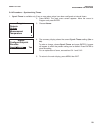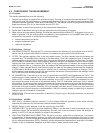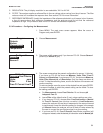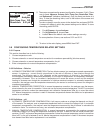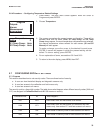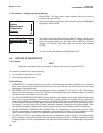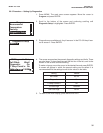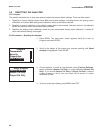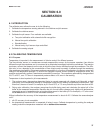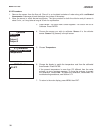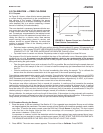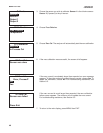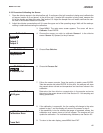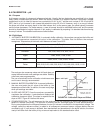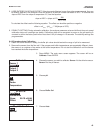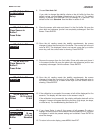
MODEL FCL-1056 SECTION 6.0
CALIBRATION
SECTION 6.0
CALIBRATION
6.1 INTRODUCTION
The calibrate menu allows the user to do the following:
1. Calibrate the temperature sensing element in the chlorine and pH sensors.
2. Calibrate the chlorine sensor.
3. Calibrate the pH sensor. Four methods are available.
a. Two-point calibration with automatic buffer recognition.
b. Manual two-point calibration.
c. Standardization.
d. Manual entry of pH sensor slope and offset.
4. Calibrate the analog outputs.
6.2 CALIBRATING TEMPERATURE
6.2.1 Purpose
Temperature is important in the measurement of chlorine and pH for different reasons.
The free chlorine sensor is a membrane-covered amperometric sensor. As the sensor operates, free chlorine
diffuses through the membrane and is consumed at an electrode immediately behind the membrane. The reaction
produces a current that depends on the rate at which the free chlorine diffuses through the membrane. The diffu-
sion rate, in turn, depends on the concentration of free chlorine and how easily it passes through the membrane
(the membrane permeability). Because membrane permeability is a function of temperature, the sensor current will
change if the temperature changes. To account for changes in sensor current caused by temperature alone, the
analyzer automatically applies a membrane permeability correction. The membrane permeability changes about
3%/°C at 25°C, so a 1°C error in temperature produces about a 3% error in the reading.
Temperature is also important in pH measurements.
1. The analyzer uses a temperature dependent factor to convert measured cell voltage to pH. Normally, a slight
inaccuracy in the temperature reading is unimportant unless the pH reading is significantly different from 7.00.
Even then, the error is small. For example, at pH 12 and 25°C, a 1°C error produces a pH error less than ±0.02.
2. During auto calibration, the analyzer recognizes the buffer being used and calculates the actual pH of the
buffer at the measured temperature. Because the pH of most buffers changes only slightly with temperature,
reasonable errors in temperature do not produce large errors in the buffer pH. For example, a 1°C error caus-
es at most an error of ±0.03 in the calculated buffer pH.
Without calibration the accuracy of the temperature measurement is about ±0.4°C. Calibrate the sensor/analyzer
unit if
1. ±0.4°C accuracy is not acceptable
2. the temperature measurement is suspected of being in error. Calibrate temperature by making the analyzer
reading match the temperature measured with a standard thermometer.
37



